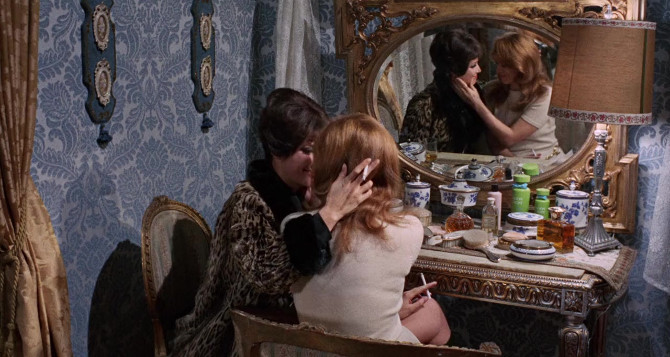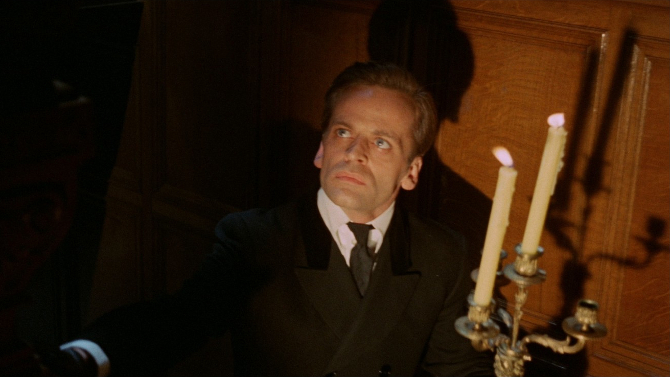‘What Could Have Been’ is a continuing look into the reels of film history, analysing movies that could have been something special, but due to script, production, budgetary, or any other type of issue, did not reach its full potential.
The Swinging Sixties were a most unique time, especially in London. Often seen as a more traditional, conservative city, the growth of this young, wild child generation clashed with their aging parents and grandparents, a kaleidoscopic counter culture seeping into the stiff upper lip backbone of the nation’s capital. Capturing 1969 London in all of its variations, Double Face, co-written and directed by Riccardo Freda, follows one man’s unlikely journey through this often unnerving world.

Klaus Kinski plays John Alexander (in a surprisingly reserved way), a wealthy, middle aged businessman with a much more traditional outlook. Quickly wedding extremely cash-happy Helen (Margaret Lee), it is a marriage that soon wallows into a depressing wake of clashes and affairs. Helen soon finds a lover, Liz (Annabella Incontrera), leading to questions of whether their union will last.
Yet, it does not take long for Helen to die in a car crash, unexpectedly leaving all of her wealth and much of her father’s (Sydney Chaplin – Charlie’s son) prolific company to her husband (though initial reports suggest no foul play, many are still suspicious of John – seeing him as the prime suspect).
Despite their flailing marriage and a surprising inheritance, John cannot fathom his wife’s horrific and unexpected death. Sitting in their gothic, wood panelled home, filled with fabulous clocks and expensive whiskeys, it is somehow more of a gilded cage, trapping him, rather than a home to flourish in.
Yet, this gilded cage isn’t very secure, and soon John enters his home one night to find a young hippie, Christine (Christiane Krüger), enjoying his shower. The teenager ensnares the spiritually wounded man, life seeping back into him through this mysterious enigma. Following her like a private eye-lost-puppy-dog, she leads him to a most swinging party – guys wildly driving motorcycles indoors, raucous music, nude dancing, and, more intriguingly, a separate room showing a porno featuring the same Christine. Yet, it is not Christine that catches his eye. . . it is the other woman in the video – hidden behind a mask, she is wearing the same jewellery and has the same scar as his supposedly dead wife. A mystery in a mask, the footage draws the man in. . . John becoming an amateur detective. Yet, as soon as the police and his father-in-law start to investigate, it seems like everything he has seen is no longer in its place. . . is John simply going mad, or is there something more sinister at work? Was Helen murdered, or could she still be alive and hiding somewhere?
Clearly a low budget film, the special effects are some of the worst you’ll see. A skiing vacation is laughably superimposed, while the car scenes come across like a boy playing with his dinky toys and a lighter. Yet, these few scenes truly don’t flaw the movie too much, for the story is more about John’s journey than the action.

Seen through Kinski’s vivid, wide eyes, director Freda and cinematographer Gábor Pogány moodily capture and light his journey, sometimes by candlelight, at other times in the ominous red of a darkroom, each stride into a new and more daunting environment. Part giallo (and definitely a neo noir), part krimi (crime), this Italian/German co-production features garish greens and reds (in the hippie scenes), opulent browns and golds (in the manor house), and moody shadow and light (while John does the dangerous investigative work on the streets, trailing individuals), it also has a certain eroticism, building a palpable tension as the story goes further and further down the proverbial rabbit hole. Fervent fans of the mystery genre will likely predict the ending, despite their best attempts to muddy the psychedelic waters. . . though that doesn’t make the journey any less engaging. It also doesn’t hurt that quite a bit of the film was shot on location in Liverpool and London. . . adding some real texture to the British set narrative.
By no means a genre gem, Double Face still does enough things right to make it a worthwhile watch for fans of this style of film. Casting an intriguing main character, this clash of cultures finds controlled and confident meeting manic and untamed, British wealth trudging through sex, drugs and rock `n roll to discover the horrible truth surrounding his never-truly-known wife. . . a very visual character on top of a stunning palette that entraps our senses. So, it is in your hands as to whether you want to double down and discover the face hidden beneath this incense-infused veil of secrecy.

